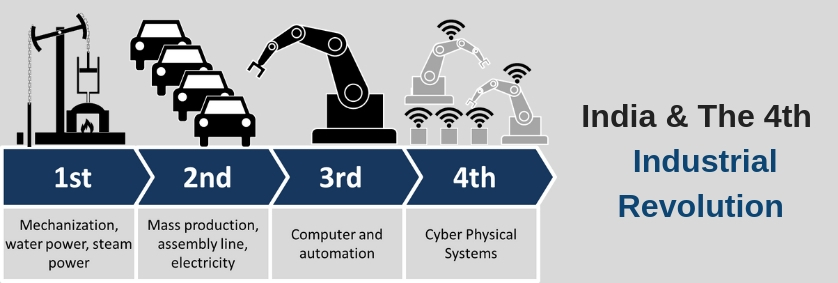Our Blog

07Sep 2018
India & The 4th Industrial Revolution
The 4th Industrial Revolution proclaims an exponential pace in technological change, expanding on digital revolution for combining technologies, creating new ones as well as changing countries, industries and systems, even the society itself.
For the developing nations, progresses in figuring connectivity, power, GIS, biotechnology and artificial intelligence, and more up to date, more proficient advancements hold enormous promise. Rural growth, structural transformation from agriculture and inclusive agriculture to high-efficiency manufacturing & other financial areas can be quickened, as innovative change changes people's lives and empowers the developing nations to advance on scales and at speeds previously unthinkable.
Be that as it may, the instance of India is remarkable on the grounds that, unlike its neighbours in the East and Southeast Asia, quick financial development has not been sufficiently comprehensive to diminish the number of Indians living in hardship. India contains the biggest number of needy individuals on the planet: 270 million, as indicated by the World Bank. Growth in employment is vital in low-profitability agriculture, which represents about 75 percent of the poor populace. However, automation debilitates to induce far more unemployment. The public policy has to be coordinated towards expanding the efficiency of destitute individuals instead of simply offering handouts.
Through its Digital India program, the Government Of India is attempting to change the nation's rustic economy and make talented employments in provincial zones. For the evaluated 156 million Indian provincial families, most living in neediness as per India's NSSO (National Sample Survey Organization), there is necessity for investment in Internet access, power and transportation to make greater work for ladies and youth in rustic regions.
Regardless of promise of technology, there remains a requirement for considerable increment in antiquated investments so as to make up for lost time with the build-up in education and physical infrastructure to accomplish a geologically more scattered improvement far from the 100 major cities. Nearly 25% of Indian grown-ups can't write or even read, and gender discrimination must be tended to with adequate investments, especially in education & training of rural women. Geographical use of new innovations is as yet constrained in rural zones; numerous farmers are still in the dark about these advances. Deficient network in these regions alongside an absence of essential knowledge of computers and thwarted literacy development all contribute towards the major problems. Considerable investment is required in education, infrastructure, transportation, broadband and power, especially in villages and among the poorest populaces with a specific end goal to really reap the benefits of the 4IR.
If you liked this post, then make sure to stay tuned to our blog space for more such interesting articles and updates.
SHARE THIS
0 Comment(s)
Leave a Comment
Latest Articles
-
How NGOs Help Elevate The Condition Of PWDs?
18th Mar, 2024 -
The Role Of Community-Based Rehabilitation Program......
08th Mar, 2024 -
How NGOs For Disabilities In India Champions For I......
16th Feb, 2024 -
The Role Of NGOs In Development Of Children With D......
05th Feb, 2024 -
How The Changing Rural Education System Is Shaping......
12th Jan, 2024






